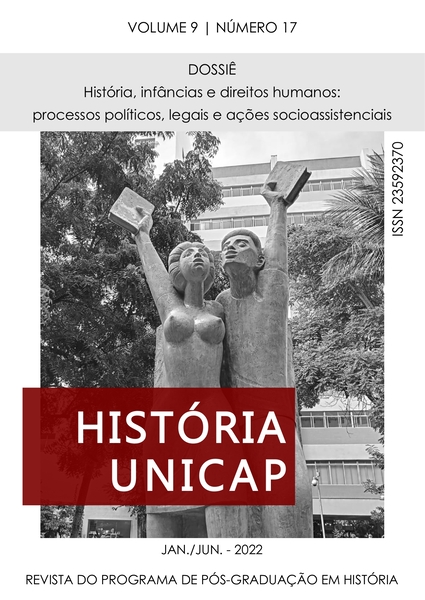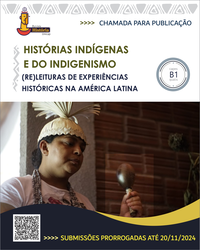The judge, the commissioners of minors and the “batters” (Recife - 1960s-1970s)
DOI:
https://doi.org/10.25247/hu.2022.v9n17.p56-70Keywords:
juvenile court; minors commissioners; Minors Code.Abstract
Looking into the collection of the periodical Dário de Pernambuco, we found a series of reports on the daily lives of boys and girls in situations of poverty, abandonment or in conflict with the law. Among the articles, it was found the report that reported the performance of the juvenile judge of Recife, Nelson Ribeiro, entitled Recovering minors is the motto of the Judiciary. From the analysis of the discourse of this matter, intersecting it with other documentary sources, the objective of this text is to problematize how the forms of social control over children and adolescents in a situation of abandonment were produced, in the period marked by the implementation of the National Policy for Welfare of Minors, which came into effect months after
the civil-military coup in 1964. In this argumentative process, the role of commissioners for minors and the discursive production on the “child issue” will be discussed, based on the argument that the juvenile court sought to act on the basis of police logic. In this way, we seek to analyze how a governmentality was built on the historically produced social problem, in the period in focus, when the “child issue” came to be conceived as a “national security issue”.
Downloads
References
ABRAMOVAY, Miriam. Gangues, galeras, chegados e reppers. Rio de Janeiro: Garamond, 2004.
AREND, Silvia Maria Fávero. Histórias de abandono. Infância e justiça no Brasil. (Década de 1930). Florianópolis: Mulheres, 2011.
BERNAL, Elaine. Arquivos do Abandono. São Paulo: Cortez, 2004.
BOEIRA, Daniel Alves. CPI do Menor: infância, ditadura e políticas públicas (Brasil, 1975-1976). 2018. 258 f. Tese (Doutorado em História). Programa de Pós-Graduação em História UDESC, Florianópolis, SC, 2018. Disponível em: https://www.udesc.br/arquivos/faed/id_cpmenu/2553/Daniel_Alves_Boeira_final_1571 3400889273_2553.pdf. Acesso em: 30 maio 2022.
BRASIL. Lei 4.242 de 6 de janeiro de 1921. BRASIL. Lei7.943-A de 12 de outubro de 1927.
BRASIL. Câmara dos Deputados. Comissão parlamentar de inquérito: CPI do Menor. Brasília: Câmara dos Deputados Centro de Documentação e Informação, 1975.
BRASIL. Câmara dos Deputados. A Realidade Brasileira do Menor. Brasília: Câmara dos Deputados - Centro de Documentação e Informação, 1976.
CERTEAU, Michel. A invenção do cotidiano: artes de fazer. 11ª Ed. Petrópolis: Vozes, 1994.
DAMINELLI, Camila Serafim. Uma Fundação para o Brasil jovem: Funabem, menoridade e políticas sociais para infância e juventude no Brasil (1964-1979). 2019. 305 f. Tese. Pós-Graduação em História, Universidade do Estado de Santa Catarina, Florianópolis, 2019. Disponível em: https://www.udesc.br/arquivos/faed/id_cpmenu/2551/Camila_Serafim_Daminelli_final
_15833439835848_2551.pdf. Acesso em: 30 maio 2022.
DIARIO DE PERNAMBUCO. Recuperar menores é lema do Juizado. Recife, 20 de janeiro de 1967.
DONZELOT, Jacques. A polícia das famílias. Rio de Janeiro: Graal, 2001. FARGE, Arlette. O sabor do arquivo. São Paulo: Editora da Universidade de São Paulo, 2009.
FRONTANA, Isabel da Cunha. Crianças e adolescentes nas ruas de São Paulo. São Paulo: Edições Loyola, 1999.
FOUCAULT, Michel. História da Sexualidade: a vontade de saber (volume 1). São Paulo: Ediçoes Graal, 2011.
MIRANDA, Humberto da Silva. Nos tempos das Febems: memórias de infâncias perdidas (Pernambuco / 1964-1985). 2014. 348 f. Tese (Doutorado), Programa de Pós- Graduação em História, UFPE, Recife, 2014. Disponível em: https://repositorio.ufpe.br/bitstream/123456789/12383/1/TESE%20Humberto%20da%2 0Silva%20Miranda.pdf. Acesso em: 30 maio 2022.
MIRANDA, Humberto. Estatuto da Criança e do Adolescente: entre a Lei e a Vida. Recife: Liceu, 2020.
MORELLI, Ailton. A criança, o menor e a lei: uma discussão em torno do atendimento infantil e da noção de inimputabilidade. 1996. 183 f. Tese (Doutorado em História)- Programa de Pós-Graduação em História, Unesp, Franca, 1996. Disponível em: https://www.aacademica.org/ailton.jose.morelli/7.pdf. Acesso em: 30 maio 2022.
PASSETTI, Edson. O que é menor. São Paulo: Editora Brasiliense, 1987PERNAMBUCO. Tribunal de Justiça. História das Comarcas Pernambucanas / Tribunal de Justiça de Pernambuco; Centro de Estudos Judiciários. 3 ed. Recife: Tribunal de Justiça de Pernambuco, 2020.
RIZZINI, Irma. Pequenos trabalhadores no Brasil. In: PRIORE, Mary Del. Histórias das crianças no Brasil. São Paulo: Contexto, 2004.
RODRIGUES, Gutemberg Alexandrino. Os filhos do mundo: a face oculta da menoridade (1964 - 1979). 2000. Dissertação (Mestrado em História)- Programa de Pós- Graduação em História. Universidade de São Paulo. São Paulo: 2000. Disponível em: https://repositorio.usp.br/item/001110274. Acesso em: 30 maio 2022.
VIANNA, Adriana de Resende. O mal que se adivinha: polícia e menoridade no Rio de Janeiro, 1910 – 1920. Rio de Janeiro: Arquivo Nacional, 1999.
Downloads
Published
Issue
Section
License
Copyright (c) 2022 HISTÓRIA UNICAP

This work is licensed under a Creative Commons Attribution 4.0 International License.
Concedo a Revista História Unicap o direito de primeira publicação da versão revisada do meu artigo, licenciado sob a Licença Creative Commons Attribution (que permite o compartilhamento do trabalho com reconhecimento da autoria e publicação inicial nesta revista).
Afirmo ainda que meu artigo não está sendo submetido a outra publicação e não foi publicado na íntegra em outro periódico e assumo total responsabilidade por sua originalidade, podendo incidir sobre mim eventuais encargos decorrentes de reivindicação, por parte de terceiros, em relação à autoria do mesmo.
Também aceito submeter o trabalho às normas de publicação da Revista História Unicap acima explicitadas.
















 A História Unicap está licenciada com uma licença
A História Unicap está licenciada com uma licença 